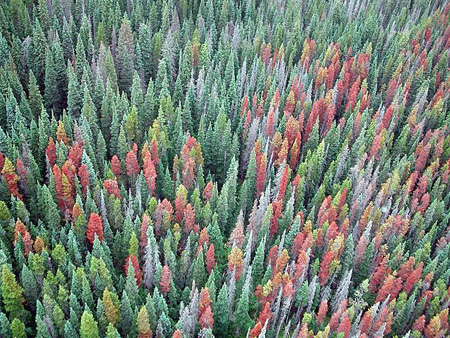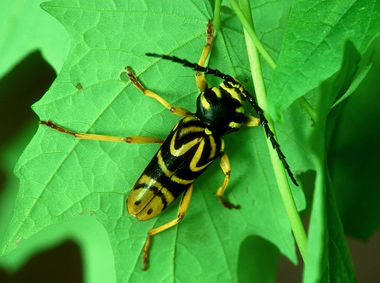Many insects are considered pests to Canada’s forests, meaning they cause significant ecological or economic damage to forest ecosystems. These species can injure trees in various ways, including boring through wood, eating leaves, and introducing pathogens to trees. These stressors can cause economic damage by reducing the amount of wood fibre that can be harvested and can sometimes negatively impact the ecosystem. While some of these pests have been recently introduced to Canadian forests from other parts of the globe, the majority of insect forest pests in Canada are native species. Under ordinary conditions, these species are natural sources of disturbance and diversity that can help to maintain healthy forests over long periods. However, human-mediated factors such as climate change, the introduction of non-native species, and biodiversity loss have more recently worsened the impacts that certain species can have on Canadian forests. Below is a list of just a few of the many such insects impacting Canadian forests, along with the estimated area of forest, in hectares, that a population outbreak defoliated or killed as well as the year that outbreak occurred.
1. Emerald ash borer — Actively spreading (2023)
The emerald ash borer (Agrilus planipennis; Agrile du frêne) is an iridescent green beetle that is narrow and only 8.5–14.0 mm in length. This species is native to the hardwood forests of East Asia and was first detected in Canada in 2002, when ash trees in Windsor, Ontario, were found to be infested. The beetle spreads through flight and, more significantly, through human timber transportation. Commonly infected timber products include firewood, nursery stock, logs, branches, wood chips and wooden packaging materials. As of 2023, the beetle has spread to Manitoba, Quebec, New Brunswick and Nova Scotia. Female emerald ash borers fly to locate their preferred host, ash trees in the genus Fraxinus, and lay their eggs into crevices in the ash tree’s bark. The larvae hatch and eat the tree’s phloem, a layer of tissue the tree uses to transport nutrients and water. Eventually, enough of the phloem is destroyed that the tree cannot survive. In several North American outbreaks, it was found that up to 99 per cent of infected trees were killed. One tree species of particular concern is the black ash tree, Fraxinus nigra, which is culturally important to many Indigenous peoples, including the Anishinaabe, Haudenosaunee, Abenaki, Ho-Chunk and Menominee. Indigenous peoples have been using black ash trees for thousands of years for material, medicinal and spiritual purposes, such as the creation of beautiful black ash baskets.

2. Eastern spruce budworm — 10 million hectares (1991)
The spruce budworm (Choristoneura fumiferana; Tordeuse des bourgeons de l'épinette) is a native species of moth that is considered by many to be the most serious pest of spruce and fir trees throughout North America. From mid-spring to early summer, the caterpillars of this species eat the needles, buds and reproductive structures of softwood trees. Population outbreaks occur every 30 to 40 years, lasting several years and causing severe defoliation of up to tens of millions of hectares of trees, which can result in a reduction in growth and even mass mortality of trees. This natural disturbance increases the structural complexity of the forest, helping to promote tree diversity in addition to providing valuable habitat for a variety of species. However, outbreaks can also result in a loss of timber resources available for harvest by the forestry industry. Human-caused changes in the species compositions of forests and climate change are both expected to exacerbate the range and severity of outbreaks in the future.

3. Spongy moth — 580,000 hectares (2020)
The spongy moth (formerly gypsy moth or LDD moth, Lymantria dispar; Spongieuse) is a Eurasian species of moth. The first spongy moth infestation in Canada occurred in Southern Quebec in 1924. As of 2023, this species has additionally established itself in Ontario, New Brunswick, PEI and Nova Scotia, with scattered populations occasionally appearing in British Columbia. The spongy moth damages trees as caterpillars by consuming the leaves and needles of trees. During a severe outbreak, trees and shrubs can be completely defoliated over large areas, with caterpillars moving from tree to tree as each runs out of leaves. The caterpillars complete their life cycle in only a few months, from late spring to mid-summer, turning into moths and laying eggs in spongy egg masses that give them their name. This gives trees time to produce a new crop of leaves in the summer, although the stress from the caterpillars’ appetite can reduce growth and introduce stressors that leave trees vulnerable to other threats.

4. Mountain pine beetle — 10 million hectares (2007)
The mountain pine beetle (Dendroctonus ponderosae; Dendroctone du pin ponderosa) is a small, brown to black beetle native to the forests of Saskatchewan, Alberta and British Columbia. Female pine beetles will bore under the tree bark to lay eggs, creating empty spaces known as “galleries” in which to lay their eggs. When the larvae hatch, they burrow through the nutrient-filled layer of wood called phloem. The damage caused by the beetles alone doesn’t usually kill the trees. However, when the mother beetles burrow beneath the bark, they carry the spores of the blue stain fungus, which causes a fungal disease that can kill the tree and destroy its value as lumber.
According to indigenous knowledge of the region, occasional outbreaks have occurred in western forests for generations, with the beetle population mediated by natural predators and cold winters. However, climate change has resulted in longer summers and milder winters, meaning the beetles have more time to reproduce and are more likely to survive until spring.

Other Cases
There are many other insect species that have significant, and sometimes growing, impacts on Canadian forests. These include native species such as the forest tent caterpillar (Malacosoma disstria) and the jack pine budworm (Choristoneura pinus), as well as non-native species such as the Asian longhorn beetle (Anoplophora glabripennis) and the birch leafminer (Fenusa pusilla). In some cases, damage caused by insects can leave trees more vulnerable to disease and even introduce pathogens directly, such as in the case of beech bark disease, a disease complex formed between a beech-scale insect and the fungus Nectria coccinea. While insect disturbance is a natural and essential part of forest ecosystems, it is important to continuously monitor the health of Canadian forests and to study the impacts of these pest species.

 Share on Facebook
Share on Facebook Share on X
Share on X Share by Email
Share by Email Share on Google Classroom
Share on Google Classroom














